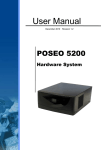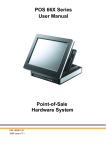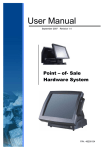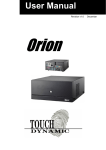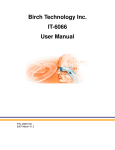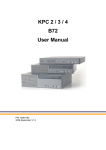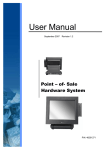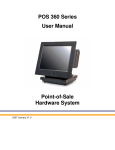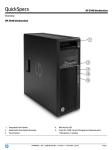Download User Manual - Support Technique AURES
Transcript
User Manual April 2010 Revision 1.1 POSEO 5100 Hardware System Copyright 2008~2010 All Rights Reserved Manual Version 1.1 The information contained in this document is subject to change without notice. We make no warranty of any kind with regard to this material, including, but not limited to, the implied warranties of merchantability and fitness for a particular purpose. We shall not be liable for errors contained herein or for incidental or consequential damages in connection with the furnishing, performance, or use of this material. This document contains proprietary information that is protected by copyright. All rights are reserved. No part of this document may be photocopied, reproduced or translated to another language without the prior written consent of the manufacturer. TRADEMARK Intel®, Pentium® and MMX are registered trademarks of Intel® Corporation. Microsoft® and Windows® are registered trademarks of Microsoft Corporation. 2 Safety IMPORTANT SAFETY INSTRUCTIONS 1. To disconnect the machine from the electrial power supply, turn off the power switch and remove the power cord plug from the wall socket. The wall socket must be easily accessible and in close proximity to the machine. 2. Read these instructions carefully. Save these instructions for future reference. 3. Follow all warnings and instructions marked on the product. 4. Do not use this product near water. 5. Do not place this product on an unstable cart,stand,or table.The product may fall, causing serious damage to the product. 6. Slots and openings in the cabinet and the back or bottom are provided for ventilation;to ensure reliable operation of the product and to protect it from overheating. These openings must not be blocked or covered.The openings should never be blocked by placing the product on a bed, sofa, rug, or other similar surface.This product should never be placed near or over a radiator or heat register,or in a built-in installation unless proper ventilation is provided. 7. This product should be operated from the type of power indicated on the marking label.If you are not sure of the type of power available, consult your dealer or local power company. 8. Do not allow anything to rest on the power cord. Do not locate this product where persons will walk on the cord. 9. Never push objects of any kind into this product through cabinet slots as they may touch dangerous voltage points or short out parts that could result in a fire or electric shock. Never spill liquid of any kind on the product. CE MARK This device complies with the requirements of the EEC directive 2004/108/EC with regard to “Electromagnetic compatibility” and 2006/95/EC “Low Voltage Directive”. FCC This device complies with part 15 of the FCC rules. Operation is subject to the following two conditions: (1) This device may not cause harmful interference. (2) This device must accept any interference received, including interference that may cause undesired operation. 3 CAUTION ON LITHIUM BATTERIES There is a danger of explosion if the battery is replaced incorrectly. Replace only with the same or equivalent type recommended by the manufacturer. Discard used batteries according to the manufacturer’s instructions. LEGISLATION AND WEEE SYMBOL 2002/96/EC Waste Electrical and Electronic Equipment Directive on the treatment, collection, recycling and disposal of electric and electronic devices and their components. The crossed dustbin symbol on the device means that it should not be disposed of with other household wastes at the end of its working life. Instead, the device should be taken to the waste collection centers for activation of the treatment, collection, recycling and disposal procedure. To prevent possible harm to the environment or human health from uncontrolled waste disposal, please separate this from other types of wastes and recycle it responsibly to promote the sustainable reuse of material resources. Household users should contact either the retailer where they purchased this product, or their local government office, for details of where and how they can take this item for environmentally safe recycling. Business users should contact their supplier and check the terms and conditions of the purchase contract. This product should not be mixed with other commercial wastes for disposal. 4 Revision History Revision Number Description Revision Date 1.0 Initial release May 2008 1.1 Updated specification table Added Appendix B: Dimensional drawings April 2010 5 Table of Content 1. Packing List.................................................................................................................... 8 2. System View .................................................................................................................. 9 2.1 Front View............................................................................................................. 9 2.2 I/O View .............................................................................................................. 10 3. Driver Installation ......................................................................................................... 11 3.1 Driver List............................................................................................................ 11 3.2 Chipset Driver Installation ................................................................................... 11 3.3 USB 2.0 Driver Installation OS Requirements..................................................... 13 3.4 VGA IEGD Driver Installation .............................................................................. 16 3.5. Audio Driver Installation ..................................................................................... 18 3.6 LAN Driver Installation ........................................................................................ 19 4. Peripherals Installation................................................................................................. 20 4.1. Cash Drawer Installation.................................................................................... 20 4.1.1 Cash Drawer Pin Assignment .......................................................................... 20 4.1.2 Cash Drawer Controller Register ..................................................................... 20 4.1.3 Cash Drawer Control Command Example ....................................................... 21 5. System Disassembly.................................................................................................... 22 5.1. Removing the Front Cover................................................................................. 22 5.2 Removing the Top Cover .................................................................................... 22 5.3 Replacing the HDD ............................................................................................. 23 5.4. Replacing the DVD-ROM (Option) ..................................................................... 24 5.5. Replacing the Power Supply.............................................................................. 25 5.6. Replacing the USB Hub & PCI Extension Module (Options).............................. 26 5.7. Replacing the Memory ....................................................................................... 27 5.8. Replacing the Motherboard................................................................................ 27 6. Specification................................................................................................................. 29 7. Motherboard, Jumper Settings, Connectors................................................................. 31 7.1 B89 Motherboard layout...................................................................................... 31 7.2 Jumper Settings .................................................................................................. 32 7.3 Connectors and Pin Assignments ....................................................................... 34 8. BIOS Settings .............................................................................................................. 36 Appendix A: PCI Card Dimensions .................................................................................. 39 Appendix B: Dimensional Drawings ................................................................................. 40 6 7 1. Packing List Take the system unit out of the carton. Remove the unit from the carton by holding it by the foam inserts. The following contents should be found in the carton: a. Power Cable b. Driver CD 8 2. System View 2.1 Front View Key Lock 1 x USB behind Battery Power front bezel LED LED (See Ch. 5.1- 5.2) 9 Power Button 2.2 I/O View AC Power COM2 & 4 COM 6 Line Out DC Output 24V COM 3 & 5 LPT 4x Cash Drawer P/S 2 Keyboard VGA COM1 DC Output 12V LAN Note: The maximum current that can be drawn from each COM port is 500 mA. Pin Assignment 1 NC 2 + 24V DC 3 GND DC output 24V Pin Assignment 10 3. Driver Installation 3.1 Driver List Folder/File File Description <CD>:\Poseo_5100.htm B89 Driver List <CD>:\Common\INTEL\Chipset\i8xx Chipset Driver <CD>:\COMMON\INTEL\VGA\i85x\Win2K_XP\CRT_ VGA IEGD Driver only\IEGD51-FT2a <CD>:\Common\Ac97_codec\Realtek\ALC202A Audio Driver <CD>:\COMMON\Lan_driver\R8139_810x 10/100Mb LAN Driver -The following procedures are for Windows XP, other platforms are similar. 3.2 Chipset Driver Installation a. Double click on “infinst_enu_6.0.1.1002” in the My Computer window. b. Click “Next”. 11 c. Click “Yes”. d. Click ”Next”. e. Click the “Finish” button to restart your system. 12 3.3 USB 2.0 Driver Installation OS Requirements OS USB 2.0 requirements Windows USB 2.0 drivers are provided in Service Pack 1 (SP1) for Windows XP XP, which is available through Windows Update. Windows USB 2.0 drivers are available through Windows Update or Service 2000 Pack 4. Windows 98SE/Me USB 2.0 drivers are available on the Intel developer site. Windows 98 (Retail) Developers and OEMs should contact Orange Ware. For end-users, if your device does not ship with Windows 98 drivers, contact your device or system manufacturer. If USB 2.0 drivers are not available, your device will operate at USB 1.1 speeds Linux USB 2.0 support is available in kernel 2.4.19 or later development kernels, or in the 2.4.19 or later production kernel. More information. a. Right click the My Computer icon on the desktop and select “properties” b. Select “Hardware””Device Manager”. 13 c. Select ”Other Devices” “Universal Serial Bus (USB) Controller” ”Properties”. d. Select “Device” “Update Driver…”. e. Click ”Next”. f. g. Select “Specify a location” and click “Next”. Select “Search for a suitable…”and click “Next”. 14 h. Click on the “Browse” button to select the driver and then click “OK” to go to i. Click “Next”. the next page. j. Click on the “Finish” button to complete this process. k. Finished. 15 3.4 VGA IEGD Driver Installation a. Select “Utilities” In the My Computer window. b. Double click the “Setup” icon. c. Select “Installs driver and application files” and click the “Next”. d. Select “I agree” and click on the “Install” button. 16 e. Click “Continue Anyway”. f. Select “No, not this time” and click “Next”. g. Click “Yes” to restart your system. 17 3.5. Audio Driver Installation a. Click “A3.71” in the My Computer window. b. Double click the “wdm_a371” icon. c. Click “Next”. d. Click “Yes”. e. Click “Finish”. 18 3.6 LAN Driver Installation a. Double click ”Setup” in the My Computer window. b. Click “Finish”. c. Click ”OK” to restart your system. 19 4. Peripherals Installation 4.1. Cash Drawer Installation You can install a cash drawer through the Cash Drawer port. Please verify the pin assignment before installation. 4.1.1 Cash Drawer Pin Assignment Pin Signal 1 GND 2 DOUT bit0 3 DIN bit0 4 12V/24V 5 DOUT bit1 6 GND 4.1.2 Cash Drawer Controller Register The Cash Drawer Controller uses one I/O address to control the Cash Drawer. Register Location: 48Bh Attribute: Read / Write Size: 8 bits 7 6 5 4 3 2 1 0 X X X X X Cash Drawer 1 “DOUT bit0” pin output control Cash Drawer 1 “DOUT bit1” pin output control Reserved Cash Drawer 1 “DIN bit0” pin input status Reserved 20 Bit 7: Reserved Bit 6: Reserved Bit 5: Reserved Bit 4: Cash Drawer “DIN bit0” pin input status. = 1: the Cash Drawer closed or no Cash Drawer. = 0: the Cash Drawer opened. Bit 3: Reserved. Bit 2: Reserved. Bit 1: Cash Drawer “DOUT bit1” pin output control. = 1: Opening the Cash Drawer = 0: Allow closing the Cash Drawer Bit 0: Cash Drawer “DOUT bit0” pin output control. = 1: Opening the Cash Drawer = 0: Allow closing the Cash Drawer Note: Please follow the Cash Drawer control signal design to control the Cash Drawer. 4.1.3 Cash Drawer Control Command Example Use Debug.exe program under DOS or Windows98 Command O 4B8 01 O 4B8 00 Cash Drawer Opening Allow to closing Set the I/O address 4B8h bit0 =1 for opening the Cash Drawer by “DOUT bit0” pin control. Set the I/O address 4B8h bit0 = 0 to allow closing Cash Drawer. Command I 4B8 Cash Drawer Check status The I/O address 4B8h bit4 =1 means the Cash Drawer is closed or no Cash Drawer. The I/O address 4B8h bit4 =0 means the Cash Drawer is open. 21 5. System Disassembly 5.1. Removing the Front Cover a. Use the key to unlock the front cover. b. Lift the front cover up as shown by the arrows and remove it. 5.2 Removing the Top Cover To remove the top cover, please follow the steps as described in chapter 5.1. USB a. Remove the screw (1) b. Loosen the thumb screws (4 - two on each side) to release the top cover from the system. Note: You can access the front USB connector after removing the front cover. 22 5.3 Replacing the HDD To remove the front cover, please follow the steps as described in chapter 5.1. a. Loosen the thumb screw (1). b. Pull the locking bar down. Pull the handle to slide out the HDD a few cm. Disconnect the two cables c. Now slide the HDD out completely and remove it from the system. d. Repeat for the second HDD (if present). 23 5.4. Replacing the DVD-ROM (Option) To remove the front and top covers, please follow the steps as described in chapter 5.1 - 5.2 a. Loosen the thumb screw (1) b. Disconnect the two cables from the DVD-ROM unit. c. Slide out the CD-ROM/DVD-ROM unit. 24 5.5. Replacing the Power Supply To replace the power supply, please follow the steps as described in chapter 5.1 and 5.2 a. Remove the screw (1) and slide the power supply outwards. b. Disconnect the cables (2) and remove the power supply. c. Remove the screws (3) to separate the power supply from the frame. 25 5.6. Replacing the USB Hub & PCI Extension Module (Options) To replace the I/O and PCI extension module, please follow the steps as described in chapter 5.1 and 5.2 a. Remove the extension module by gently pulling it upwards taking care not to damage the connector. b. Remove the screws (2) and disconnect the cables (3) to remove the USB hub from the holder. c. Disconnect the cables (2) and remove the screws (2) to release the PCI riser card from the holder. 26 5.7. Replacing the Memory To replace the memory, please follow the steps as described in chapter 5.1, 5.2 , 5.5(a+b) and 5.6(a) a. Use your finger to push the DIMM slot ejector clips into the down position. b. Remove the memory module from the slot. 5.8. Replacing the Motherboard To replace the motherboard, please first follow the steps as described in chapter 5.1, 5.2, 5.3(a+b), 5.5(a) and 5.6(a) b. Remove the screw (1) and disconnect a. Disconnect the cables (2), remove the the cables (9) as shown in the picture. screws (2) and slide the HDD module in the direction as shown by the arrows to release the module from the motherboard Chassis 27 c. Remove the screws (7) d. Remove the hex nuts (17) to release the motherboard from the chassis 28 6. Specification Motherboard B89 CPU Support Intel SK478 CPU Celeron 2.5G Chipset INTEL 852GM + ICH4 System Memory up to 2GB DDR 400MHz RAM, 2 RAM-DIMM Storage HDD ODD 2x3.5" HDD _PATA 1xSlim CD-ROM/CD-RW/DVD_ROM Drive bay(option) Expansion PCI slot 1 External I/O Ports Front I/O USB 1 (USB 7) Power Button 1 Rear I/O PS/2 keyboard 1 USB Powered Serial / COM 4(USB3~6) 5 (COM1/ COM2 / COM3 / COM4 / COM5) Serial RS232/RS485/RS422 1 (COM6) Cash drawer port 1 VGA 1 ( DB-15) Line-out 1 LAN (10/100) 1 Parallel 1 DC 24V output 1 DC 12V output 1 (for OLC 8.4 VESA power) Optional Module: USB Hub Powered USB (12V) 2 Powered USB (24V) 1 Powered USB (5V) 1 USB 4 29 Peripheral (special feature) System ID 1 Power button 1 (pin header) Control/ Indicator Power button 1 (Front) LED HDD/Power 2 Environment EMC & Safety Operating FCC Class A, CE, LVD 5oC ~ 35 oC (41 oF ~ 95 oF) Temperature Storage Temperature -10 oC ~ 60 oC (14 oF ~ 140 oF) Operating Humidity 20% - 85% RH non condensing Storage Humidity 5% - 90% RH non condensing 270 x 300 x 120mm Dimension (W x D x H) Power requirements Power Supply 230W 30 7. Motherboard, Jumper Settings, Connectors 7.1 B89 Motherboard layout B89 Motherboard 31 7.2 Jumper Settings = Factory Default Setting 1. COM1 / COM2 / COM3 / COM4 / COM5 Power Setting COM Port Jumper COM1 JP4 COM2 JP8 COM3 Pin Function Jumper Setting DCD# 1 1-2 +5V 3-4 JP6 +12V 5-6 COM4 JP5 RI# 7-8 COM5 JP3 +5V 9-10 +12V 11-12 9 2. COM 6 RS232/ 485/ 422 Setting Function RS232 JP9 (1-2) v JP9 (3-4) v RS485 JP9 (4-6) JP9 (5-7) v v JP9 (7-8) v JP9 (9-10) JP10 (1-2) RS422 v v v JP10 (3-4) JP10 (5-6) v JP10 (7-8) v JP10 (9-10) v JP10 (11-12) v 3. 2ND Display Power Setting Function JP11 (SHORT) +12V 1-2 NC 1 32 4. CMOS Operation Mode Setting Function JP13 (SHORT) COMS Normal N/C COMS Reset 1-2 5. Power Mode Setting Function JP15 (SHORT) ATX Power N/C AT Power 1-2 6. Cash Drawer Power Setting Voltage JP7 (SHORT) 1-2 +12V 3-4 + 24V 7. ACPI Mode Setting Function JP12 (SHORT) Disable 1-2 Enable N/C 8. CPU Frequency Setting Function JP14 (SHORT) 1-2, 3-4 FSB400 3-4 FSB533 9. CPU Voltage Setting CPU Type JP16 P4 1-2, 3-4, 5-6 7-8, 9-10, 11-12 P4-M(1.3V) Perf. Mode Note: OPEN N/C SHORT 33 JP17 N/C 3-4, 9-10 1-2(NC), 5-6(NC) 7-8(NC), 11-12(NC) 7.3 Connectors and Pin Assignments CN4: COM6 RS232/422/485 Pin 1 DB9_1 Pin 2 DB9_2 Pin 3 DB9_3 Pin 4 DB9_4 Pin 5 GND Pin 6 RS232_6_DSR# Pin 7 RS232_6_RTS# Pin 8 RS232_6_CTS# Pin9 RS232_6_RI Pin 10 N/C CN6: Speaker & MIC Connector Pin 1 LIN_OUT_L Pin 2 GND Pin 3 GND Pin 4 LIN_OUT_R Pin 5 GND Pin 6 MIC1 CN7: CD-IN & Line-In Connector Pin 1 CDIN_L Pin 2 CDIN_REF Pin 3 CDIN_R Pin 4 CDIN_REF Pin 5 GND Pin 6 LINE_IN_L Pin 7 LINE_IN_R Pin 8 GND GND Pin 2 PWR_OK Pin 1 +5V_USB1 Pin 2 USB20_R_P1- Pin 3 USB20_R_P1 + Pin 4 GND CN8: Hardware Reset Pin 1 CN10: USB5 CN12: Power LED Pin 1 +5V Pin 2 GND Pin 2 SW_PWRBT# CN13: Power Button Pin 1 GND 34 CN15: HDD Power Connector Pin 1 +12V Pin 2 GND Pin 3 GND Pin 4 +5V CN16: CD-ROM Power Connector Pin 1 +12V Pin 2 GND Pin 3 GND Pin 4 +5V CN17: HDD Power Connector Pin 1 +12V Pin 2 GND Pin 3 GND Pin 4 +5V CN18: Power Connector external 12V Power connector Pin 1 +12V Pin 2 GND Pin 3 GND (not used) Pin 4 +5V (not used) Pin 2 +5V CN19: IDE LED Pin 1 HDD_LED# FAN_CPU3: CPU FAN CONTROL Pin 1 GND Pin 3 FB Pin 2 +12V 35 8. BIOS Settings 8.1 BIOS Setup Utility The BIOS setup defines how the system is configured. You need to run this program the first time you configure this product. You may need to run it again if you change the configuration. You need to connect a PC keyboard to the keyboard connector to run the BIOS setup utility. 8.2 Starting the BIOS Setup 1. Turn on or reboot this product. 2. Press the DEL key immediately after the product is turned on, or press the DEL key when the following message is displayed during POST (the Power on Self-Test). Press DEL to enter SETUP. 3. The main menu of the BIOS setup is displayed. 4. If the supervisor password is set, you must enter it here. If, after making and saving system changes with the Setup utility, you find that this product no longer boots, start the BIOS setup and execute the following. 8.3 When a Problem Occurs Load Optimized Defaults 8.4 BIOS Main Menu When the BIOS Main Menu is displayed, the following items can be selected. Use the arrow keys to select items and the Enter key to accept and enter the sub-menu. Note: The BIOS menu below is from B99 RAID BIOS version B990V10.BIN. If you have a different BIOS version, the contents of the menu may different. 36 Standard CMOS Features Use this menu for basic system configuration. Advanced BIOS Features Use this menu to set the Advanced Features available on the system. Advanced Chipset Features Use this menu to change the values in the chipset registers and optimize the system’s performance. Integrated Peripherals Use this menu to specify your settings for integrated peripherals. Power Management setup Use this menu to specify your settings for power management. PnP/PCI Configurations This entry appears if your system supports Plug and Play and PCI Configuration. PC health status Displays CPU, System Temperature, Fan Speed, and System Voltages Value. Load Optimized Defaults Use this menu to load the BIOS default values, i.e., factory settings for optimal performance 37 system operations. While Award has designed the custom BIOS to maximize performance, the factory has the option to change these defaults to meet their needs Set Supervisor Password Enables you to change, set, or disable the supervisor or user password Set Password Change, set, or disable the password. It allows you to limit access to the system and to the setup, or just to the setup. Save & exit setup Save CMOS value changes to CMOS and exits setup. Exit without saving Ignores all CMOS value changes and exits setup. 38 Appendix A: PCI Card Dimensions Maximum dimension of the PCI add-on card: Component Side: 130mm x 90.26mm ( D x W ) (Picture 1) 39 Appendix B: Dimensional Drawings All dimensions in mm 40 41









































